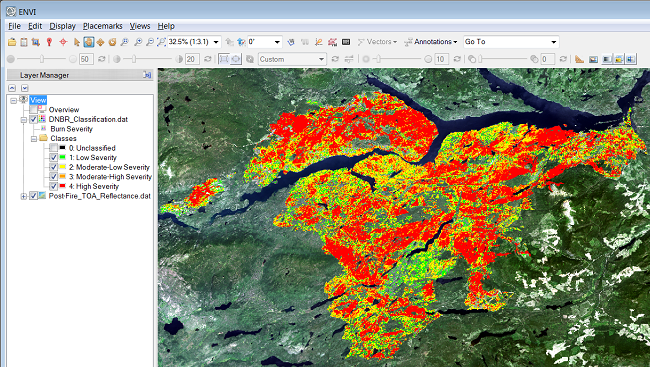Burn Severity Analysis of the Chelaslie River Forest Fire
Anonym
In my previous blog post back in January of this year I discussed "Using SWIR and LWIR Imagery to Analyze Forest Fires" which involved using Landsat 8 OLI/TIR data to analyze the Chelaslie River forest fire in British Columbia last summer (2014). In the earlier blog post I describe utilization of ENVI's Spectral Indices tool to compute the Normalized Burn Ratio (NBR) index for a scene that was acquired while the fire was still actively burning. As I mentioned in this previous blog post "the real power of the Normalized Burn Ratio spectral index is exhibited when you create pre-fire and post-fire NBR images then subtract the post-fire NBR raster from the pre-fire NBR raster to create a Differenced Normalized Burn Ratio (DNBR) image that indicates burn severity". However, at that time I was unable to find a good post-fire Landsat scene as most had either clouds or snow obscuring the burned areas.
Now that several months of summer 2015 have passed it occurred to me that it's worth another search of the Landsat archive available on USGS EarthExplorer to see if a new scene is available that provides a good post-fire capture of the Chelaslie River forest fire area. As luck would have it Landsat 8 acquired a nice cloud-free (at least over the fire area) scene just in the past month on 05 July 2015 that happens to be the same exact path/row as a pre-fire Landsat 7 scene acquired on 09 July 2002. The DNBR index can be calculated using a series of simple processing steps followed by the PreFireNBR - PostFireNBR equation which can easily be executed using the Band Math tool within the ENVI software.
Here's a quick high-level synopsis of the processing steps:
- Open both pre-fire and post-fire Landsat datasets
- Run the Radiometric Calibration tool
- Calibrate both datasets into top-of-atmosphere (TOA) at-sensor reflectance
- Run the Spectral Indices tool
- Calculate the Normalized Burn Ratio index for both datasets
- Run the Band Math tool
- Enter simple "b1 - b2" subtraction expression
- Map pre-fire NBR to "b1" and post-fire NBR to "b2"
- Apply a raster color slice to the output DNBR raster
- Convert the raster color slice to a classification image with specific class names & colors
Below is a screenshot of the DNBR classification overlaid on top of the post-fire Landsat image with class names based on the "FIREMON BR Cheat Sheet V4 (June 2004)" document.

Image data downloaded from USGS EarthExplorer